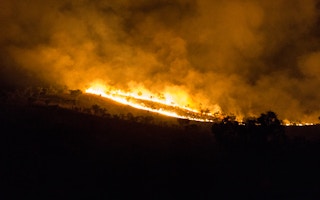Climate-heating emissions from Australia’s devastating bushfires are now nearly on a par with those caused by fires in the Amazon rainforest last year, scientists have calculated.
Australia’s bushfires, from September to Jan. 6, emitted 370 million tonnes of carbon dioxide, according to the European Union’s ECMWF Copernicus Atmosphere Monitoring Service (CAMS).
By comparison, fires from Brazilian states in the Amazon Basin, which sparked global attention, emitted 392 million tonnes of greenhouse gases from Jan. 1 to Nov. 15 last year.
“People are not grasping the carbon consequences,” Joe Fontaine, a lecturer in environmental science at Murdoch University in Perth, said of the Australian fires.
The estimate of their carbon emissions “is sobering and depressing”, he told the Thomson Reuters Foundation.
So far 27 people have been killed, thousands made homeless and thousands more evacuated repeatedly as the monster fires have scorched large swathes of Australia, especially in its southeast.
While media coverage has largely focused on the devastating impacts on people and wildlife, together with air pollution, Prime Minister Scott Morrison has been criticised over apparent attempts to play down the role of climate change in the crisis.
Most scientists say the fires have been exacerbated by a nationwide three-year drought they link to climate change.
Global warming is making extreme events like droughts, heatwaves and bushfires more intense and more likely, said Adam Hodge, a regional information officer with the United Nations Environment Programme in Bangkok.
“
People are not grasping the carbon consequences [of such huge fires].
Joe Fontaine, lecturer in environmental science, Murdoch University
“Bushfires are normal in Australia as part of the natural cycle, but by some estimates the scale of the current infernos may be the worst on record,” he said.
” They are a harbinger of things to come. These are the effects we are seeing in a world that has warmed 1.1 degrees (Celsius) above the pre-industrial average,” he added.
Australia contributes 1.3 per cent of global carbon emissions but is the second-largest emitter per capita behind the United States. Brazil is the seventh-largest emitter of heat-trapping gases.
Tackling climate change would help prevent catastrophes like the recent fires, Hodge said, adding that “countries are not doing enough to fight climate change”.
Natural fires
Making comparisons between fire emissions data from Australia and Brazil is complex due to different fire dynamics, such as the type of vegetation and how fires are started, said Mark Parrington, a senior scientist at CAMS in Reading, England.
“A lot of fires across the tropics are started deliberately, often for agriculture,” he said.
“There have also been fires related to deforestation in Brazil … whereas in Australia, it’s a country that has a (natural) fire habitat, so fire is part of the ecosystem.”
Tallying emissions across regions can also politicise the issue and shift the focus to other countries, he said.
Despite spikes in areas hit by bushfires, Australia is experiencing an average year for emissions from fires at a national level, a CAMS spokeswoman said, although the last four months of emissions were above average.
Since 2010, Australia’s average annual fire-related emissions have been 440 million tonnes, with the record being 916 million tonnes in 2011.
Globally, the number of fires and related emissions mostly declined over the last several decades, Parrington noted.
Fire emissions may also be compensated for by regrowth when the vegetation recovers in burned areas, carbon experts say.
According to Global Forest Watch, a forest monitoring service, from October to Jan. 8 in Australia’s New South Wales, Queensland, South Australia and Victoria, fire alert zones covered about 13.3 million acres (5.4 million hectares).
Meanwhile, the size of the area that experienced fires in the Brazilian state of Amazonas throughout 2019 totalled 1.4 million acres (567,000 hectares), it added.
Fontaine, who researches bushfires and fire management, said Australia needed to invest more in research to strengthen its understanding of fires and what it faces now and in the future.
Fire risks should be managed better and funding increased to speed up response, including a larger professional firefighting force, alongside help for people to get insurance, he added.
Fontaine said the 370 million tonnes of carbon emissions from the fires so far equalled about two-thirds of annual emissions for the Australian continent from all sources.
“There were some very spatially extensive fires in the 1970s but … the carbon intensity of these fires is number one,” he said.
This story was published with permission from Thomson Reuters Foundation, the charitable arm of Thomson Reuters, that covers humanitarian news, climate change, resilience, women’s rights, trafficking and property rights. Visit http://news.trust.org/climate.








